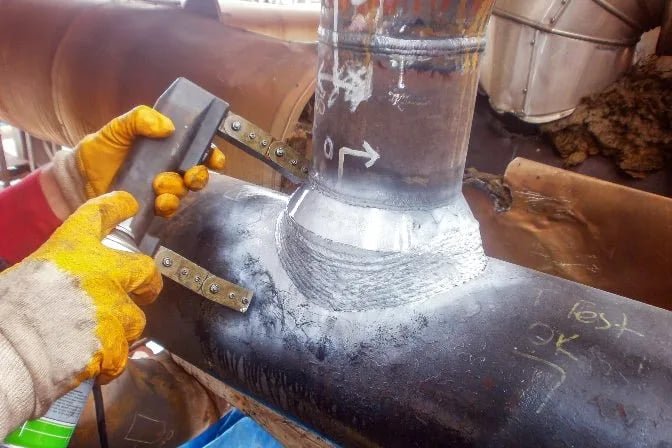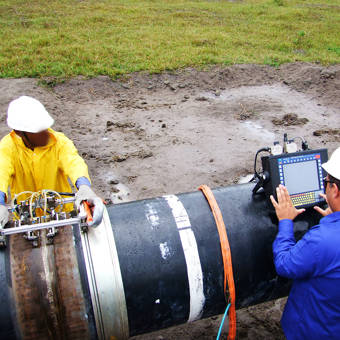Accuracy Issues: Relied On Pipeline Welding Inspection Providers for Essential Tasks
Accuracy Issues: Relied On Pipeline Welding Inspection Providers for Essential Tasks
Blog Article
Comprehensive Overview of Pipeline Welding Examination Procedures
Pipeline welding inspection treatments play a vital function in guaranteeing that bonded links meet stringent sector requirements and specs. From meticulous pre-welding assessments to detailed post-weld evaluations, a distinct assessment process is vital for preserving the structural strength of pipelines.
Pre-welding Inspection Preparations
Before commencing the welding process, thorough pre-welding examination preparations are crucial to make sure the honesty and top quality of the weld joint. These preparations include a precise assessment of the materials to be welded, the welding tools, and the work environment. By performing comprehensive pre-welding inspection prep work, prospective issues can be recognized and fixed early on, leading to reliable and high-grade weld joints.
Welding Procedure Qualification
Complete pre-welding evaluation prep work lay the foundation for the critical procedure of Welding Procedure Certification, ensuring the honesty and high quality of the weld joint. Welding Procedure Qualification (WPQ) is an essential action in the welding process that entails screening and certifying welding procedures to assure they meet details standards and demands. The WPQ process normally includes welding treatment requirements advancement, welding treatment certification screening, and paperwork of the results.
During welding treatment spec growth, crucial details such as the welding procedure, welding products, joint design, and welding specifications are specified to develop a detailed treatment. Subsequently, welding treatment certification testing is performed to validate the suggested treatment's honesty. This testing typically entails welding examination discount coupons that undergo various mechanical and non-destructive tests to examine the weld's quality and adherence to the specified requirements.
In-process Weld Assessment
Throughout the welding procedure, in-process weld evaluation plays an essential function in making sure the quality and honesty of the weld joint - Pipeline Welding Inspection. This kind of inspection includes checking the welding parameters, evaluating the weld grain formation, and detecting any type of possible problems or gaps as they take place. By carrying out in-process weld inspections, welding drivers can without delay address any problems that might arise, thereby stopping further flaws and guaranteeing that the final weld fulfills the required specifications
Typical techniques made use of for in-process weld evaluation include visual evaluation, fluid penetrant testing, magnetic particle screening, ultrasonic testing, and radiographic testing. Generally, in-process weld assessment is necessary for keeping the top quality and dependability of bonded pipelines.
Non-destructive Testing (NDT)
Non-destructive Testing (NDT) is a crucial technique employed in pipeline welding examination to evaluate the integrity of weld joints without triggering damage to the bonded structure. By using various NDT strategies, examiners can evaluate the quality of welds and identify any problems or suspensions that might endanger the architectural strength of the pipeline. Typical NDT approaches used in pipeline welding evaluation include Radiographic Testing (RT), Ultrasonic Testing (UT), Magnetic Bit Checking (MPT), Fluid Penetrant Testing (LPT), and Visual Screening (VT)
RT includes using X-rays or gamma rays to create photos of the internal framework of the weld, enabling examiners to find issues such as porosity, splits, or insufficient combination. UT utilizes high-frequency acoustic waves to discover problems below the surface of the weld, offering detailed details concerning the dimension and place of problems. MPT and LPT are used to identify surface-breaking issues by using magnetic bits or penetrant liquids to the weld location. Additionally, VT involves aesthetic assessment of welds to determine any type click resources of visible blemishes.
Post-weld Examination and Documents


Paperwork of post-weld evaluation findings is essential for maintaining quality control documents and making sure compliance with industry criteria and policies. Comprehensive reports ought to consist of info regarding the examination methods made use of, the area and nature of any flaws found, and any type of corrective actions taken - Pipeline Welding Inspection. click to find out more Correct documentation not only functions as a record of the weld's high quality however additionally aids in future maintenance and examination processes
Final Thought

Finally, pipeline welding assessment procedures play a crucial function in ensuring the high quality and honesty of welds. From pre-welding evaluations to post-weld documents, each step is crucial in preserving the safety and security and effectiveness of pipelines. By complying with recognized treatments and carrying out complete assessments, potential defects can be recognized and dealt with before they bring about costly repair work or failures. Generally, adherence to correct inspection procedures is vital to the success of pipe welding projects.
From thorough pre-welding examinations to comprehensive post-weld assessments, a well-defined evaluation process is vital for keeping the structural soundness of pipelines. By carrying out in-process weld assessments, welding drivers can without delay attend to any type of problems that might emerge, therefore making certain and stopping additional problems that the final weld satisfies the required specs.
Usual methods used for in-process weld assessment include visual examination, liquid penetrant testing, magnetic particle testing, ultrasonic testing, and radiographic screening.Non-destructive Testing (NDT) is a vital method used in pipeline useful reference welding examination to examine the integrity of weld joints without creating damage to the bonded structure. Post-weld inspection includes various approaches to evaluate the welds for issues, including aesthetic evaluation, color penetrant testing, magnetic fragment testing, ultrasonic screening, and radiographic testing.
Report this page